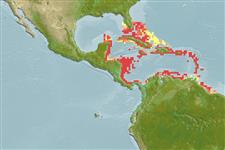Common names from other countries
Classification / Names / Names
Namen | Synonyme | Catalog of Fishes (gen., sp.) | ITIS | CoL | WoRMS
Environment: milieu / climate zone / depth range / distribution range
Ökologie
Riff-verbunden; tiefenbereich 0 - 23 m (Ref. 83922). Tropical; 28°N - 6°N, 89°W - 55°W (Ref. 4)
Western Atlantic: Caribbean Arc from Cuba to Trinidad, Los Roques.
Length at first maturity / Size / Gewicht / Alter
Maturity: Lm ? range ? - ? cm Max length : 20.0 cm TL Männchen/unbestimmt; (Ref. 271); common length : 15.0 cm TL Männchen/unbestimmt; (Ref. 4)
It has lengths of 20 cm, maximum total body length; 15 cm, common length (Ref. 4). Maximum depth range from Ref. 122059. Exclusively inhabits coral reefs (Ref. 106828). Also occurs in shallow waters and inhabits rocky areas, mainly in crevices (Ref. 4), seagrasses and rubble (Ref. 97531). Nocturnal omnivore (Ref. 106982).
Life cycle and mating behavior
Geschlechtsreife | Fortpflanzung | Ablaichen | Eier | Fecundity | Larven
Members of the order Decapoda are mostly gonochoric. Mating behavior: Precopulatory courtship ritual is common (through olfactory and tactile cues); usually indirect sperm transfer.
Holthuis, L.B. 1991. (Ref. 4)
IUCN Rote Liste Status (Ref. 130435)
CITES Status (Ref. 108899)
Not Evaluated
Not Evaluated
Nutzung durch Menschen
Fischereien: kommerziell
| FishSource |
Tools
Mehr Information
Alter/GrößeWachstumLänge-GewichtLänge-LängeMorphologieLarvenDichte
Internet Quellen
Estimates based on models
Preferred temperature
(Ref.
115969): 26.7 - 28.3, mean 27.6 (based on 331 cells).
Verwundbarkeit
Low vulnerability (10 of 100).
